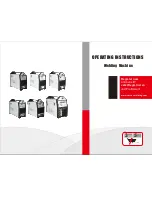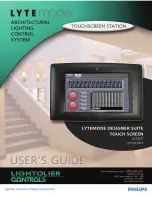
USE AND INSTALLATION MANUAL
0001268 edition: 1/22.03.2021
Page
6
of
8
11. GENERAL SAFETY RULES
Periodically examine connections and fitting of
components of the equipment to prevent any accidental
loosening or disconnection.
•
it is forbidden to use a combination of the equipment
where function of any one component is affected by, or
interferes with the function of any other.
•
before each use of personal fall protection equipment, a
pre-use check should be carried out to ensure that it is in
a serviceable condition and operates correctly.
12. ESSENTIAL PRINCIPLES FOR USE OF
PERSONAL FALL PROTECTION EQUIPMENT
•
For rescue operation with descending use a descender
device for rescue compliant with EN 341.
•
The device must be used in accordance with instruction
manuals of personal fall protection equipment and
standards:
EN 361 - full body harnesses
EN 352-3; EN 355; EN 360 - personal fall protection
equipment
EN 362 - connectors
EN 795 / TS16415 - anchor points
•
personal fall protection equipment should be used only by
personnel trained in its use.
•
personal fall protection equipment must not be used by a
person with medical condition that could affect safety of
the equipment user in normal and emergency use.
•
prepare a rescue plan to be implemented whenever
necessary.
•
it is forbidden to make any alterations or additions to the
equipment without prior written consent given by the
manufacturer.
•
any repair shall only be carried out by manufacturer of the
equipment or an authorised representative.
•
personal fall protection equipment shall not be used for
any purpose other than intended.
•
personal fall protection equipment provides individual
protection and shall be used by one person only.
•
before each use make sure that all parts of fall protection
system cooperate correctly.
•
in particular, inspect all accessible elements of the
equipment for any damages, excessive wear, corrosion,
abrasion, cutting or improper function. For individual
devices pay particular attention to:
in full body harnesses and work positioning devices:
buckles, regulating elements, attachment points
(buckles), webbings, seams, belt loops;
in energy absorbers: attachment loops, webbings,
seams, housing, connectors;
in lanyards and textile guides: rope, loops, thimbles,
connectors, regulating parts, splices;
in lanyards and steel guides: rope, wires, clamps,
loops, thimbles, connectors, regulating parts;
in retractable type fall arresters: lanyard or webbing,
retractor and locking mechanism for proper
operation, housing, energy absorber, connectors;
in guided type fall arresters: body, proper guiding,
locking mechanism for proper operation, rollers, bolts
and rivets, connectors, energy absorber;
in connectors (snap hooks): load-bearing body,
rivets, main pawl, locking mechanism functionality.
•
at least once a year, after each 12 months of use,
personal fall protection equipment must be
withdrawn from use to carry out periodic detailed
inspection. Periodic inspection can be carried out by
a person who is responsible for periodic inspections
in user’s organisation and properly trained in this
respect. Periodic inspections can be carried out also
by the manufacturer of the equipment or his
authorized representative, or an authorized
company. Inspect in detail all accessible elements of
the equipment paying attention to any damages,
excessive wear, corrosion, abrasion, cutting or
incorrect function (see the above item.) In some
cases, if fall protection equipment has a complex
design (e.g. fall arresters), periodic inspections can
be carried out by manufacturer of the equipment, or
his authorized representative only. After the periodic
inspection, date of the next inspection should be
marked.
•
Regular periodic inspections are essential in respect
of the equipment condition and safety of users which
is dependent on functionality and durability of the
equipment.
•
during periodic inspection it is necessary to check the
legibility of all markings on the equipment (identity
label of the device).
BEFORE OPERATION MAKE SURE
THAT WORK ROPE IS NOT
DAMAGED
INSPECT THE FUNCTION OF
FRICTION BRAKE
DURING RESCUE USE SPRING-
TYPE ENERGY ABSORBER SDW


























